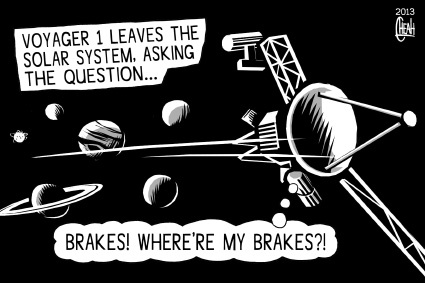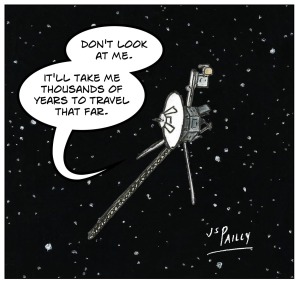Thank you so much for all that information. I loved the story about how there’s sort of an invisible barrier at the edge of our solar system. When voyagers went into it the level of radiation was high then suddenly it went away which meant it was finally outside our solar system.Out there: NASA says its Voyager 1 probe has become first spacecraft to leave the solar system
By Associated Press, Updated: Thursday, September 12, 2:40 PM
LOS ANGELES Voyager 1 has crossed a new frontier, becoming the first spacecraft ever to leave the solar system, NASA said Thursday.
Thirty-six years after it was launched from Earth on a tour of the outer planets, the plutonium-powered probe is more than 11 1/2 billion miles from the sun, cruising through interstellar space the vast, cold emptiness between the stars, the space agency said.
Voyager 1 actually made its exit more than a year ago, according to NASA. But its not as if theres a dotted boundary line or a signpost out there, and it was not until recently that scientists with the space agency had enough evidence to say that the probe had finally plowed through the hot plasma bubble surrounding the planets and escaped the suns influence.
http://www.washingtonpost.com/busin...a9b094-1bd4-11e3-80ac-96205cacb45a_story.html
Voyager has left the Heliopause which is the boundary where outward pressure from the stream of charged particles (the solar wind) coming off the Sun meet the interstellar medium to the point where the pressure drops to zero. But Voyager 1 is still going through a series of magnetic bubbles that surround the Sun and beyond that may be a thing called the Oort Cloud where comets come from, though we cannot see that far to be sure of anything.. Voyager 1's trip was cut short after Saturn in November, 1980 and never made it to any other planets because at the last minute they decided to change course to take a look at Saturn's moon Titan. That turned out to be a lost cause (Titan is covered with an orange hydrocarbon smog) so they saw nothing, and that sent Voyager 1 out of the solar system from there.
But in a few months, you can take a look at it! Unlike Voyager 2 which is far into the Southern Hemisphere in the constellation Pavo where you need to be in the deep southern hemisphere to see, you CAN look at Voyager 1! It is in the late Spring sky right near the head of Hercules (he's upside down), right where the red line ends. This is not hard to find at all if you know the sky a little or consult a sky atlas. Just look for the two bright stars, Arcturus in Bootes (lower right) and Vega in Lyra (top of picture). Here is a segment of a chart I made a few months ago showing where to look:
View attachment 178182
I think they'll follow Voyager 1 a few more years as long as they can until either the transmitter gives out (the nuclear reactor has already long outlasted its design), or the signal gets too weak to hear (whether it is responding to OUR signal to transmit or just gets too faint). They are close to that point I believe if not already past it. Voyager 1 is around 17 light/hours from Earth now.
Yesterday they were talking about planet 9 out at the edge and it puts all of the planets slightly off tilt. It may destroy all of the planets. And it’s so far away it’s not even confirmed yet? Huh? Please keep blowing my mind with science








